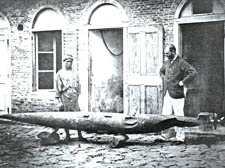|
|
 |
| |

Robert Whitehead, inventor of the torpedo, and grandfather of the Von Trapps |
The explosion of new industry
The people behind the Industrial Revolution, and the Von Trapps’ development of deadly maritime weaponry, are revealed in a new book, writes Dan Carrier Order this book
AN ear-piercing screech split the air as the projectile flew upwards. It landed with a crash at the foot of the Highgate garden and cleaved a large crater in the lawn.
Despite the damage to the grass, the garden’s owner was more than pleased, for steel-maker Henry Bessemer was test-firing shells into the air above his home and marking where they landed. The results from this dangerous and anti-social experiment were to prove financially satisfying.
Bessemer’s story is just one of the many fascinating tales told in the pages of social historian Gavin Weightman’s new book. Rather than investigate the technological leaps that changed the face of the world between 1776 and 1914, Weightman has chosen to consider the people behind the inventions, and chronicle their “Eureka!” moments.
Bessemer’s work eventually led to the discovery of how to forge steel cheaply and quickly – an invention that changed the world.
Weightman charts a vast range of topics, from the invention of cars and bikes and railways, through to food colouring and cloth dyes, from the creation of massive industrial plants through to more everyday items such as how Charles Macintosh invented the raincoat.
Bessemer is a good example: he had made his fortune after discovering a process for mass-producing a false gold powder that had a number of applications, including the manufacture of gold paint – a popular decoration during the Victorian period. He spent a fair whack of his newly found wealth on the lease of a home in Highgate.
He wrote in his autobiography of the happiness he found at his new abode: “The bronze business was now progressing most satisfactorily. I had given up many of my former employments, and felt that I might indulge in luxuries from which I had hitherto abstained. I thought that a brougham would be useful to me, and, at the same time, a source of much pleasure to my wife and children; but I had no suitable place for it at Baxter House. I imagined that I needed a meadow for a horse, but it is most probable that it was really for myself that I felt the need of ‘pastures new’; for the instinct of the village boy was evidently in the ascendant, and I sighed for the large kitchen garden, and the poultry-yard, and other rural delights, the very thoughts of which had long slumbered and been forgotten.”
It led him up Highgate Hill.
He continues: “The result of all these aspirations was the taking on, a fourteen years’ lease, of a house, the grounds of which abutted on the beautifully wooded domain of Lady Burdett Coutts, at Highgate; and here I built a large conservatory, kept my cows and Shetland ponies, played at cricket or quoits on summer evenings, and could sometimes, in my quiet walks round my own meadows, almost fancy myself again a village boy.”
Bessemer had become interested in finding a way of making a more accurate gun for the troops fighting in the Crimean War. Despite the fact the conflict had been badly managed, it nevertheless proved to be a crucible for some major advances. Florence Nightingale helped shape the future of medical care in the hospitals of Scutari, while navvies won previously unheard of respect for building a railway in a matter of weeks to send supplies to the base at Balaclava. And Bessemer put his mind to improving the accuracy of the muskets and cannon by forging metal that could be rifled. In turn, this led to a whole host of new metal objects that surround us today.
Other stories which stand out include that of Georg Von Trapp and the development of the torpedo.
Georg was a young officer in the Austro-Hungarian navy and was sent to New York to study submarine design. At the naval engineering company where he was employed, he met and fell in love with a girl called Agathe, the granddaughter of the man who invented the torpedo, Robert Whitehead. Georg became a U-boat commander and helped refine the designs that made submarines seaworthy.
In 1922 his wife died, leaving him with five young children to care for. Georg found a governess called Maria, a nun, to care for his children.
Maria taught the children to sing and Georg fell in love with her. Renouncing her vows, they married. When the family lost their cash in the Depression they took to the road, performing under the name The Von Trapp Family Singers, until they fell foul of the Nazis and fled to the US.
If this sounds too much like a certain smash-hit Rodgers and Hammerstein musical, that’s because it is: The Sound of Music was based on the true story of the Von Trapps, who were the great-grandchildren of the man who invented the torpedo.
It is charming tales like this that illuminate this wonderful book, and show the human side of the inventions that created the modern world.

|
 |
|
 |
 |
|
 |
|



